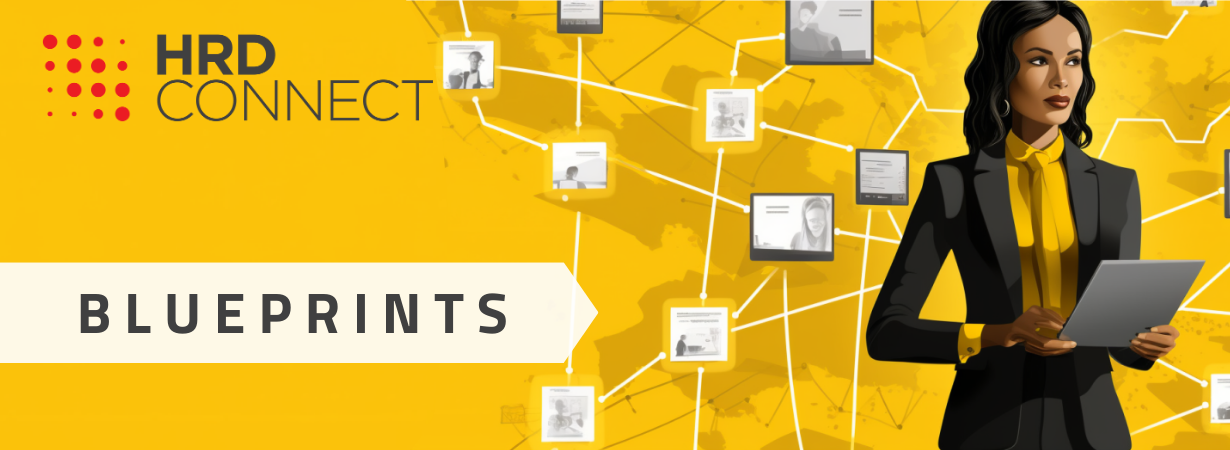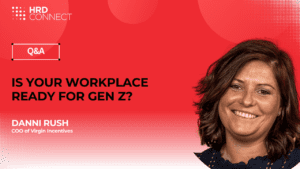Blueprint: How to build an alumni engagement platform
- 9 Min Read
Discover how to establish an alumni engagement platform designed to bring benefits from widening your talent pool to strengthening your employer brand
- Author: HRD Connect
- Date published: Sep 27, 2023
- Categories

The modern HR leader understands that the relationships we cultivate with employees extend beyond their tenure within the company. These former employees, our alumni, are not just remnants of the past; they are potential ambassadors, a talent pool for re-hire, potential clients or partners, and a reflection of our corporate legacy. But how do you transform this latent network into a thriving, mutually beneficial ecosystem? How can you ensure that both the organization and the alumni derive tangible value from such an engagement? This blueprint, tailored for senior HR leaders of major enterprises, delves deep into the creation of a robust alumni engagement platform.
Through its five pivotal steps, you’ll gain insights into planning, developing the platform, effective outreach strategies, capitalizing on career opportunities, and ensuring the platform’s sustainability through continuous improvement. The meticulous design of each step is geared towards maximizing the strategic value of your alumni network, turning it into a force that bolsters your organization’s brand, operations, and strategic vision.
Step 1: Planning and strategy
Embarking on the journey to create an alumni engagement platform demands an intricate planning and strategic approach. A clear roadmap ensures that even the most ambitious projects don’t stray off course.
Firstly, establish the goals and objectives of your platform. Are you looking to create a hub for career opportunities, or do you want to foster a vibrant community centered on communication? By setting a clear purpose, you shape all future decisions.
Next, identify your platform’s target audience with precision. Different alumni generations may have unique expectations and preferences. By segmenting this audience, you can tailor features and communication methods effectively.
Research becomes your best ally at this stage. Delve into successful alumni engagement platforms to understand their strategies, user experiences, and feature sets. This benchmarking not only provides valuable insights but also helps you avoid common pitfalls.
Budgeting is crucial. Draft a budget that covers every aspect of the platform, from technological acquisitions to marketing campaigns. A well-prepared budget ensures the longevity of the project and wards off unforeseen expenses.
- Why it matters: A robust plan establishes a solid foundation for the platform, ensuring clarity in purpose, audience engagement, and streamlined execution.
- How to execute: Bring cross-functional teams together early, gain insights through in-depth research, and refine the strategy using ongoing feedback.
- Who to engage: Collaborate closely with senior figures such as the Chief Human Resources Officer, Chief Information Officer, Chief Marketing Officer, and key finance stakeholders.
- Tools and resources: Leverage project management platforms for seamless team collaboration and consider survey platforms for gauging alumni needs and preferences

Step 2: Alumni engagement platform development
Transforming your alumni engagement vision into reality necessitates thoughtful platform development. This is where the rubber meets the road—where decisions impact both usability and engagement.
Your first action is to evaluate the various software and tools designed specifically for alumni engagement platforms. Each platform has its own unique set of features, scalability options, and pricing models. Careful assessment ensures that you choose a platform that dovetails perfectly with your organizational needs and budget constraints.
Upon selecting a software solution, customization is the next pivotal step. Here, you’re laying down the canvas that your alumni will interact with. You should align the platform features with the objectives of your strategy. Common elements include job listings, networking opportunities, communication channels, and alumni profiles.
Testing is imperative before the official launch. A dedicated team should vet the platform’s functionality and user-friendliness. The focus should be on intuitive navigation, efficient problem-solving, and, of course, the absence of glitches.
Lastly, ensure that you have implemented the highest level of security measures. Data privacy and security should never be compromised. This not only protects your alumni but also shields your organization from potential legal repercussions.
- Why it matters: The choice and development of the platform have direct implications on engagement levels, user satisfaction, and overall project success.
- How to execute: Prioritize features based on strategic objectives, conduct thorough pre-launch testing, and continuously iterate based on feedback.
- Who to engage: Include Tech Leads from IT, Product Managers from your digital team, and high-level executives such as the Chief Technology Officer and Chief Security Officer.
- Tools and resources: Utilize software evaluation platforms to compare options and employ robust security solutions to ensure data integrity.

Step 3: Alumni engagement platform outreach and communication
Your platform may be a marvel of modern engineering, but without effective communication and outreach to fill it with the right alumni, it remains an empty shell. This step is akin to setting the stage for a grand performance; your audience must be keenly aware and excited about the upcoming act.
Kick off this process by identifying and compiling a comprehensive list of alumni contacts. This task is not merely clerical; it’s strategic. Filter your alumni database to pinpoint those who can truly enrich your platform, whether through mentorship, networking, or potential re-hiring.
Your next course of action is to establish a robust communication plan. This isn’t a one-off email blast, but a meticulously designed set of messages aimed to inform, engage, and motivate. Your aim is not just to make alumni aware of the platform, but to draw them into active, sustained participation.
To amplify your reach, create compelling content and promotional materials. These can range from success stories of alumni who have benefited from similar platforms to insider views of upcoming events or opportunities exclusive to your community.
Lastly, diversify your communication channels. While email newsletters can be impactful, don’t underestimate the power of social media, virtual alumni events, and even good old-fashioned snail mail to add a personal touch.
- Why it matters: Effective communication establishes the necessary pull factor, transforming passive alumni into active community participants.
- How to execute: Adopt a multi-channel approach and tailor messages for various alumni segments to enhance engagement.
- Who to engage: Communications specialists, digital marketing experts, and high-level stakeholders like the Chief Marketing Officer should be integral parts of this phase.
- Tools and resources: Employ customer relationship management software and social media management platforms to coordinate and track communication efforts.

Step 4: Career opportunities
Creating a dynamic alumni engagement platform is not just about keeping in touch; it’s about actively contributing to the career development of your alumni. Think of it as a symbiotic relationship: your alumni can benefit from exclusive opportunities, and your organization can tap into a pool of proven talent.
Begin by establishing partnerships with companies and organizations to provide unique job opportunities for alumni. These partnerships should not be randomly selected. Leverage the industry knowledge and network of your organization to identify companies that align with your alumni’s skill sets, ambitions, and career goals.
Create a dedicated section on your platform specifically for career opportunities. This is your marketplace, and its success hinges on how well you manage the supply and demand of opportunities. Regular updates and quality checks are non-negotiables.
Support your alumni in their job search by offering career development resources. This could be in the form of webinars, downloadable guides on resume writing, or virtual workshops on interview preparation and negotiation tactics.
Finally, track the success of alumni securing job opportunities through your platform. Not just as a KPI, but as a story to tell, an affirmation that your platform delivers concrete value.
- Why it matters: Career development opportunities cement the platform’s value proposition, making membership highly beneficial for alumni.
- How to execute: Coordinate with external partners and internal recruitment teams to curate a valuable pool of opportunities.
- Who to engage: Talent acquisition leads, corporate partnership managers, and a senior leadership representative like a COO or Head of Strategic Partnerships should spearhead this initiative.
- Tools and resources: Use analytics tools to track alumni engagement with job postings and advanced matchmaking algorithms to recommend relevant opportunities.

Step 5: Continuous improvement and evaluation
An alumni engagement platform is not a set-it-and-forget-it endeavor. To maintain its relevance and efficacy, constant monitoring and timely updates are indispensable. This is where a data-driven approach intersects with human insights to guide your platform toward long-term success.
Start by gathering feedback from alumni and platform users to pinpoint areas ripe for improvement. The best solutions often arise from those who use the platform the most. Run routine polls, or better yet, organize small feedback sessions with select users to dive deep into their experiences and suggestions.
Couple this qualitative data with quantitative metrics. Your analytics dashboard should give you comprehensive insights into engagement levels, content popularity, and the ROI on career opportunities. Adjust features, designs, and strategies based on these concrete data points.
Furthermore, conduct surveys or interviews to assess the overall satisfaction and engagement levels of alumni. Frame these not as a post-experience questionnaire but as a continuous feedback loop that helps you adapt to their evolving needs.
Finally, don’t just collect this information—act on it. Revise, optimize, and retest platform features to ensure they meet your intended goals and the evolving expectations of your alumni.
- Why it matters: A stagnating platform is a disengaging one. Constant improvement ensures sustained relevance.
- How to execute: Assign a dedicated team or individual to collate and analyze data, both qualitative and quantitative, on a regular basis.
- Who to engage: Data analysts for metrics interpretation, UX/UI designers for platform optimization, and community managers for alumni engagement.
- Tools and resources: Data analytics platforms for metric tracking and feedback management software to collate user responses.

The value of an alumni engagement platform
Implementing this blueprint transforms your alumni network into a strategic asset. It sets up a dynamic, adaptable platform that serves not just the needs of past employees, but also fuels your organization’s goals through talent pipelines and business opportunities. By leveraging real-time metrics, you’re equipped to make agile decisions aligned with organizational aims.
As the business landscape evolves, maintaining a pulse on alumni sentiment and engagement will be essential. Future considerations should include the incorporation of advanced analytics and machine learning algorithms to predict alumni behavior and preferences, thereby maximizing the platform’s ROI.










